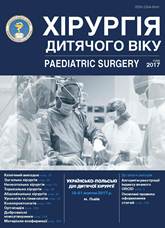Combined treatment of pronation foot deformities in children with cerebral palsy
DOI:
https://doi.org/10.15574/PS.2017.56.109Keywords:
pronation foot deformation, cerebral palsy, surgical treatmentAbstract
Pronation foot deformity is a serious complication in 57.7% – 85.3% cases of cerebral palsy. Until now, the treatment algorithm of this pathology depending on the type of clinical treatment, degree of deformity and age of the patient has not been determined.Objective: to determine the treatment algorithm in management of the various clinical course types of pronation foot deformities in children with cerebral palsy.
Material and methods. The treatment of pronation foot deformities in 45 children aged 5 to 16 years with cerebral palsy was analyzed: 18 patients were with the 1st type of deformation, 16 – the second type and 11 – the third type. Clinical and X-ray diagnostic methods were used. A combination of conservative and surgical treatment was used.
Results. Surgical treatment included restoration of the heel and talus bones by elongation or shortening of tendon and aponeurosis of the triceps muscles, transplantation of tendons, subtalar arthroereisis or arthrodesis, and three-articular arthrodesis. The study of the treatment outcomes during two years of follow-up after the operation showed good results with the 1st foot deformation type in 88.9%, excellent with the II–III types and good results in the rest cases.
References
Danilov OA, Pilipchuk OR, Mashurenko VI, Neh AA. (2007). Anatomicheskie izmeneniya bedrennyih i bolshebertsovyih kostey u bolnyih s tserebralnyim paralichom. Paediatric Surgery Ukraine. 1(4): 8–13.
Danilov OA, Motsya MA, Pilipchuk OR. (2015). Mehanizm formirovaniya i klinicheskoe techenie sgibatelnyih kontraktur kolennyah sustavov u bolnyih s tserebralnyim paralichom. Paediatric Surgery Ukraine. 1-2 (50–51): 61–67.
Danylov OA, Horelik VV, Kysylenko AS et al. (2005). Kompleksne likuvannia ploskovalhusnykh deformatsii stop u ditei z tserebralnym paralichem. Ortopediia, travmatolohiia i protezuvannia. 2: 34–57.
Husainov NO. (2014). Torsionnaya deformatsiya nizhnih konechnostey u bolnyih tserebralnyim paralichom. Ortopediya, travmatologiya i vosstanovitelnaya hIrurgIya detskogo vozrasta. 2; 1: 63–68.
Dolgin DA, Delwart RJ, Stefro RM. (1998). Distal tibial fibular deratation osteotomy for correction of tibial torsion: review of technique and results in 63 cases. J Pediatrik Orthopedic. 25(6): 697–708.
Ryan DD, Rethlefsen SA, Sraggs DZ, Kay RM. (2005). Results of tibial rotation osteotomy without concomitant fibular osteotomy in children with cerebral palsy. J Pediatrik Orthopedic. 25(1): 84–88. https://doi.org/10.1097/01241398-200501000-00019; https://doi.org/10.1097/00004694-200501000-00019; PMid:15614066
Danylov OA, Shulga OV, Gorelik VV, Abdalbari J. (2016). The mechanism of formation and clinical course of pronation foot deformity in children with the cerebral palsy. Surgery of Ukraine. 4(60): 18–23.
Delp SZ, Hess WE, Hungerford DS, Jones ZC. (1999). Variation of rotation moment arms with hip flexion. J Biomechanik. 32(5): 493–501. https://doi.org/10.1016/S0021-9290(99)00032-9
Downloads
Issue
Section
License
The policy of the Journal “PAEDIATRIC SURGERY. UKRAINE” is compatible with the vast majority of funders' of open access and self-archiving policies. The journal provides immediate open access route being convinced that everyone – not only scientists - can benefit from research results, and publishes articles exclusively under open access distribution, with a Creative Commons Attribution-Noncommercial 4.0 international license(СС BY-NC).
Authors transfer the copyright to the Journal “PAEDIATRIC SURGERY.UKRAINE” when the manuscript is accepted for publication. Authors declare that this manuscript has not been published nor is under simultaneous consideration for publication elsewhere. After publication, the articles become freely available on-line to the public.
Readers have the right to use, distribute, and reproduce articles in any medium, provided the articles and the journal are properly cited.
The use of published materials for commercial purposes is strongly prohibited.

